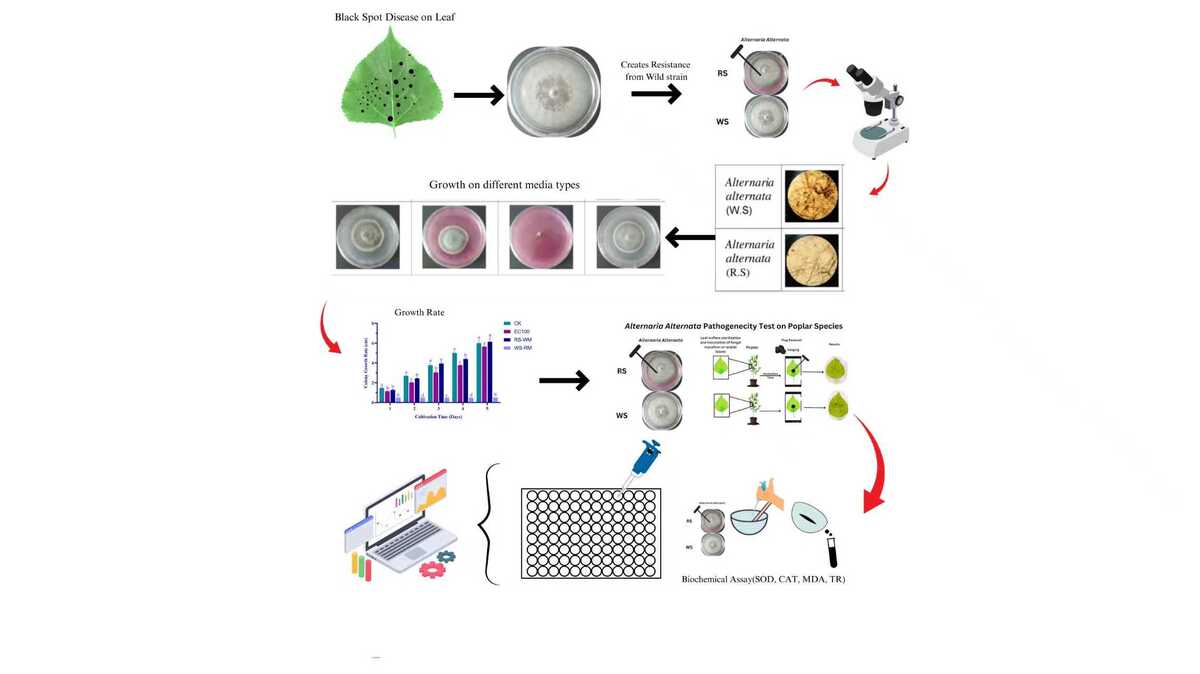ORIGINAL ARTICLE
Unraveling the Fungicide Resistance in Alternaria alternata through Integrated Enzymatic, Phenotypic, and Colony Growth Analysis
1
School of Forestry, Northeast Forestry University, 1, 150040, Harbin, China
2
Northeast Asia Biodiversity Center, Northeast Forestry University, 1, 150040, Harbin, China
3
Key Laboratory of Forest Plant Ecology, College of Chemical Engineering and Resource Utilization. Northeast Forestry University, 1, 150040, Harbin, China
A - Research concept and design; B - Collection and/or assembly of data; C - Data analysis and interpretation; D - Writing the article; E - Critical revision of the article; F - Final approval of article
Submission date: 2024-11-27
Acceptance date: 2025-02-10
Online publication date: 2025-02-19
Corresponding author
HIGHLIGHTS
- Investigated the activity of antioxidant enzymes of A. alternata
- Alternaria alternata growth rates on fungicide-treated media were evaluated
- Alternaria alternata's soluble protein content was measured
- Studied and contrasted the phenotypic characteristics of Alternaria alternata
- Investigated oxidative stress reactions and fungal resistance
KEYWORDS
TOPICS
ABSTRACT
Alternaria alternata causes black spots in a variety of fruits and vegetables. There are major post-harvest losses due to a hidden fungus that develops when fruits are kept in the cold and appear during the fruit marketing season. This study investigated how A. alternata develops resistance to fungicides and how growth rates are affected by various growth media. According to the results, the resistant strain grew more slowly in the EC100 medium than in the control media, which showed significant differences in radial growth across media. On the other hand, the wild strain in resistant media (WS-RM) showed less development, whereas the resistant strain in wild media (RS-WM) showed more growth. Wild strains multiplied, whereas resistant strains showed decreased mycelial growth. Biochemical assays revealed significant variations between resistant and wild strains. These distinctions are highlighted by the linear correlation (R2 = 99.38%) between protein concentrations and absorbance variation. The wild strains' control protein ratio (CPr) was 0.192, whereas the resistant strains were 0.187. The mean values of MDA (360.89 nmol mg⁻¹ protein), CAT (35.54 U ml⁻¹ protein), SOD (179.60 U ml⁻¹ protein), and tyrosinase (52.18 U ml⁻¹ protein) in resistant strains were significantly higher than those in wild strains (MDA: 179.19, CAT: 11.91, SOD: 161.36, tyrosinase: 23.90). Standard deviations for all enzymes were more significant in resistant bacteria, indicating increased variability. According to the pathogenicity test conducted on Populus nigra leaves, the resistant strain's enzymatic reactions were demonstrated by the CK leaves' continued health, the RS plants' negligible symptoms, and the WS leaves' severe necrosis. These results highlight the necessity of more investigation into the molecular pathways underpinning interactions between plants and pathogens to create focused defense strategies. Improving crop tolerance to fungus infections and environmental stressors may result in more efficient treatments, lower agricultural losses, and forest protection.
CONFLICT OF INTEREST
The authors have declared that no conflict of interests exist.
We process personal data collected when visiting the website. The function of obtaining information about users and their behavior is carried out by voluntarily entered information in forms and saving cookies in end devices. Data, including cookies, are used to provide services, improve the user experience and to analyze the traffic in accordance with the Privacy policy. Data are also collected and processed by Google Analytics tool (more).
You can change cookies settings in your browser. Restricted use of cookies in the browser configuration may affect some functionalities of the website.
You can change cookies settings in your browser. Restricted use of cookies in the browser configuration may affect some functionalities of the website.




